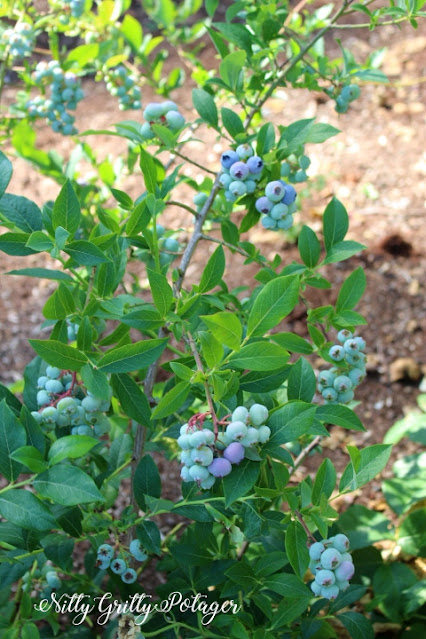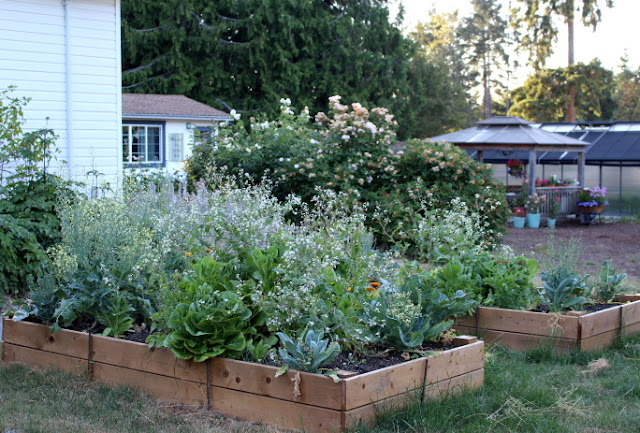July Potager Ramblings ... After The Heatwave
Garlic... I am harvesting every few days. I have 14 varieties that are all ready at different times, or at least different by a few days so that I can spread out the harvest so that I only have to deal with cleaning a couple dozen at a time. I have lifted 5 varieties thus far so 9 to go.
Squash of all kinds, winter and summer, make both male and female blossoms, these blooms are only open for one day. You need both a male and a female to be open at the same time for pollination to occur and this can sometimes take a while. Once they do, the bees go from flower to flower to pollinate them. Some folks will hand pollinate the females in order to ensure pollination.
What can you do about it? Plant lots of squash. They do not have to be the same kind to pollinate each other… can be zucchini, pumpkins, pattypans, etc... ideally it is summer squash that pollinate summer squash, winter with winter, but do not stress it if not. As long as there is a male and a female flower blooming at the same time, you will get squash : )
Feeding - Anything growing in pots, planters, or baskets will need a feed this month.
Annual flowers need a weekly or bi-weekly feed in order to keep blooming as they will soon use up the nutrients in their pots/baskets. I use a general 15-30-15 or similar, something with a bigger middle number to keep the flowers blooming all summer long.
Roses, bay trees, citrus trees, olives, etc.. that stay in pots year round, will get a shovelful or two of manure as a top dressing to keep them happy and thriving. If you have a slow release fertiliser, this can be mixed in with the manure.
Peppers and tomatoes in pots get a tablespoon or two of Epsom salts on top of the pots. Tomatoes are fed with an organic tomato fertiliser every now and again, peppers only if they look peaked and need a boost.
In the garden - I do not usually feed anything the veggies in the garden as the soil is fed with compost and manure annually and sometimes we add organic feed to the planting hole. Everything should be performing nicely.
If your soil is not up to snuff yet, if it is new and you are just starting to build it up, you can either feed the plant or feed the soil once or twice a month. To feed the plant, use a liquid seaweed or manure tea to spray onto the foliage or water in with an organic vegetable food. To feed the soil, side dress between the rows and around the plants with really good compost or manure, they will get a slow feed each time you water.
Pest control - Your flowers should be all starting to flower and thrive now, attracting all sorts of beneficial insects to your garden.
If you were to sit in the garden and watch for a bit, I bet you will find ladybugs or other insects taking care of your pest problems. As I picked peas yesterday, I noticed a few green aphids crawling around the pathway. They must have been hiding in the vines. While I kept on picking, I saw a few ladybugs in the area, as well. During the short time that I was out there, they had already taken care of quite a few of those aphids. I just walked away and left them to their business.
Ideally, do not spray with anything, even organic safe sprays, if you do not have to. Wait it out a bit to see if nature does not help you out with that.
Find pockets in the garden to sow more seeds into for late summer, fall, and winter vegetables.
The garlic bed? - After harvesting your garlic, you have an entire bed sitting empty. If you use the same bed for your garlic again in the fall, you only have three months to go from seed to harvest. It cannot be greens and such as garlic beds are in a full sun location so is too hot for greens. I have tried different things throughout the years and find that bush beans, daikon radishes, turnips, kohlrabi, and cucumbers work the best. They thrive in the heat, grow quickly, are harvestable in late August and throughout September so that I can feed my bed with compost and plant next year’s garlic.
If you will not be using this same bed, if you are rotating your crops, this bed is fantastic for your fall, winter, and next spring veggies.
Spring veggie bed - If you have some brassicas, greens, lettuces, etc.. that are just about finished, harvest them before they bolt and use that space for planting.
Interplant - Sow seeds in rows between your summer crops. Carrots, spring onions, beets, turnips and other small root crops are great to toss in between your brassicas, your rows of lettuce, in the tomato bed…
What can you be planting/sowing right now?
Carrots - This week is your last week to toss in some more carrot seeds. It will be too late for them to size up if they are not in the ground before mid-month. I would not even leave it that long. The 7th to the 10th is usually my cut off date. Keep seeds moist until the germinate! Water once or twice daily, cover with burlap sacks to help hold in moisture till you see sprouting.
Potatoes - you can grow a late crop if you plant right now, ones that will be ready for Thanksgiving dinner. This is especially successful in grow bags or pots.
Harvesting potatoes... if your spuds have flowered, you can start to harvest a plant or two at a time for dinner. If you want storage potatoes, leave the rest in the ground till late summer when the vines have yellowed and died down. When this happens, they will have put on their thicker skins that makes them good for storage.
Brassicas - Start these now in pots or 6 packs or can be direct sown now if you can find the room. Here are some ideas of what you need to start soon in order to grow fall and winter crops. If you do not have the time or energy, the shops and market growers will have some for purchase in August.
Broccoli - for eating in fall
Sprouting broccoli - for eating in early spring
Cauliflower - for fall harvest
Cauliflower (Galleon ) to eat in spring.
Beets - for fall
Cabbage - overwintering kind ( Ballhead, Early Jersey Wakefield, Deadon…)
Daikon - grow for fall harvest or can be left in garden and harvested as needed
Kale
Kohlrabi - can be sown this month and harvested throughout the fall and winter
Lettuces and greens
Peas - sow these towards the end of the month for a fall harvest
Turnips - succession sow all summer and into early fall
Walla walla - start now to transplant next month and harvest next year in late spring
What is wrong with my tomatoes with Craig Lehoulier. What's Wrong With My Tomatoes? | Solve Tomato Problems | joe gardener®
This link about the tomato industry will make you sad and mad Episode 803 - Epic Tomatoes With Craig LeHoullier - Growing A Greener World®
How to prune your salvias right now... Salvia care: How to get the best from your salvias - The English Garden
Happy Gardening - Tanja


















Comments
Post a Comment